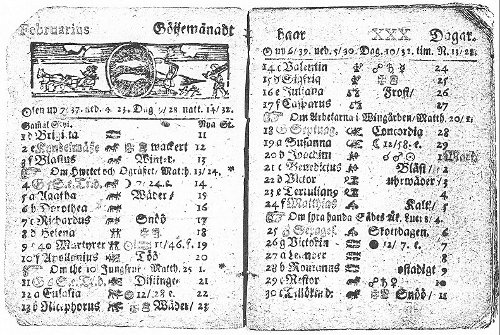The Gregorian calendar

Today’s Gregorian date:
What is the Gregorian calendar?
The Gregorian calendar is the one commonly used today. It was proposed by Aloysius Lilius (a Calabrian who had studied medicine and astronomy in Naples) and adopted by Pope Gregory XIII (pictured above) in accordance with instructions from the Council of Trent (1545-1563) to correct for errors in the older Julian Calendar. It was decreed by Pope Gregory XIII in a papal bull on 24 February 1582. This bull is named “Inter Gravissimas” after its first two words.
In the Gregorian calendar, the tropical year is approximated as 36597/400 days = 365.2425 days. Thus it takes approximately 3300 years for the tropical year to shift one day with respect to the Gregorian calendar.
The approximation 36597/400 is achieved by having 97 leap years every 400 years.
What years are leap years?
The Gregorian calendar has 97 leap years every 400 years:
Every year divisible by 4 is a leap year.
However, every year divisible by 100 is not a leap year.
However, every year divisible by 400 is a leap year after all.
So, 1700, 1800, 1900, 2100, and 2200 are not leap years. But 1600, 2000, and 2400 are leap years.
Isn’t there a 4000-year rule?
It has been suggested (by the astronomer John Herschel (1792-1871) among others) that a better approximation to the length of the tropical year would be 365969/4000 days = 365.24225 days. This would dictate 969 leap years every 4000 years, rather than the 970 leap years mandated by the Gregorian calendar. This could be achieved by dropping one leap year from the Gregorian calendar every 4000 years, which would make years divisible by 4000 non-leap years.
This rule has, however, not been officially adopted.
Don’t the Greeks do it differently?
When the Orthodox church in Greece finally decided to switch to the Gregorian calendar in the 1920s, they tried to improve on the Gregorian leap year rules, replacing the “divisible by 400” rule by the following:
Every year which when divided by 900 leaves a remainder of 200 or 600 is a leap year.
This makes 1900, 2100, 2200, 2300, 2500, 2600, 2700, 2800 non-leap years, whereas 2000, 2400, and 2900 are leap years. This will not create a conflict with the rest of the world until the year 2800.
This rule gives 218 leap years every 900 years, which gives us an average year of 365218/900 days = 365.24222 days, which is certainly more accurate than the official Gregorian number of 365.2425 days.
However, this rule is not official in Greece.
When did country X change from the Julian to the Gregorian calendar?
The papal bull of February 1582 decreed that 10 days should be dropped from October 1582 so that 15 October should follow immediately after 4 October, and from then on the reformed calendar should be used.
This was observed in Italy, Poland, and Spain/Portugal. Other Catholic countries followed shortly after, but Protestant countries were reluctant to change, and the Greek orthodox countries didn’t change until the start of the 1900s.
Changes in the 1500s required 10 days to be dropped.
Changes in the 1600s required 10 days to be dropped.
Changes in the 1700s required 11 days to be dropped.
Changes in the 1800s required 12 days to be dropped.
Changes in the 1900s required 13 days to be dropped.
(Exercise for the reader: Why is the error in the 1600s the same as in the 1500s.)
The following list contains the dates for changes in a number of countries. It is very strange that in many cases there seems to be some doubt among authorities about what the correct days are. Different sources give very different dates in some cases. The list below does not include all the different opinions about when the change took place. Also, please note that for some countries the date below indicates the time when the Gregorian calendar replaced another (non-Julian and non-Gregorian) calendar.
- Albania:
- December 1912
- Armenia:
- 1920
- Austria:
- Different regions on different dates
Brixen, Salzburg and Tyrol:
5 Oct 1583 was followed by 16 Oct 1583
Carinthia and Styria:
14 Dec 1583 was followed by 25 Dec 1583
See also Czechoslovakia and Hungary - Belgium:
- See the Netherlands
- Bulgaria:
- 31 Mar 1916 was followed by 14 Apr 1916
- Canada:
- Different areas changed at different times.
Newfoundland and Hudson Bay coast:
2 Sep 1752 was followed by 14 Sep 1752
Mainland Nova Scotia:
Gregorian 1605 - 13 Oct 1710
Julian 3 Oct 1710 - 2 Sep 1752 (note that this switch to the Julian calendar
meant that the days 3-13 October 1710 occurred twice)
Gregorian since 14 Sep 1752
Rest of Canada:
Gregorian from first European settlement - China:
- The Gregorian calendar replaced the Chinese calendar in 1912, but the Gregorian calendar was not used throughout the country until the communist revolution of 1949.
- Czechoslovakia (i.e. Bohemia and Moravia):
- 6 Jan 1584 was followed by 17 Jan 1584
- Denmark (including Norway):
- 18 Feb 1700 was followed by 1 Mar 1700
- Egypt:
- 1875
- Estonia:
- 31 Jan 1918 was followed by 14 Feb 1918
- Finland:
- Then part of Sweden. (Note, however, that Finland later became part of Russia, which then still used the Julian calendar. The Gregorian calendar remained official in Finland, but some use of the Julian calendar was made.)
- France:
- 9 Dec 1582 was followed by 20 Dec 1582
Alsace: 5 Feb 1682 was followed by 16 Feb 1682
Lorraine: 16 Feb 1760 was followed by 28 Feb 1760
Strasbourg: February 1682 - Germany:
- Different states on different dates:
Catholic states on various dates in 1583-1585
Prussia: 22 Aug 1610 was followed by 2 Sep 1610
Protestant states: 18 Feb 1700 was followed by 1 Mar 1700
(Many local variations) - Great Britain and colonies:
- 2 Sep 1752 was followed by 14 Sep 1752
- Greece:
- 15 Feb 1923 was followed by 1 Mar 1923
- Hungary:
- 21 Oct 1587 was followed by 1 Nov 1587
- Ireland:
- As Great Britain
- Italy:
- 4 Oct 1582 was followed by 15 Oct 1582
- Japan:
- The Gregorian calendar was introduced to supplement the traditional Japanese calendar on 1 Jan 1873.
- Latvia:
- During German occupation 1915 to 1918
- Lithuania:
- 1915
- Luxemburg:
- 14 Dec 1582 was followed by 25 Dec 1582
- Netherlands:
-
Zeeland, Brabant, and the “Staten Generaal”:
14 Dec 1582 was followed by 25 Dec 1582
Holland:
1 Jan 1583 was followed by 12 Jan 1583
Limburg and the southern provinces (currently Belgium):
20 Dec 1582 was followed by 31 Dec 1582
or
21 Dec 1582 was followed by 1 Jan 1583
Groningen:
10 Feb 1583 was followed by 21 Feb 1583
Went back to Julian in the summer of 1594
31 Dec 1700 was followed by 12 Jan 1701
Gelderland:
30 Jun 1700 was followed by 12 Jul 1700
Utrecht and Overijssel:
30 Nov 1700 was followed by 12 Dec 1700
Friesland:
31 Dec 1700 was followed by 12 Jan 1701
Drenthe:
30 Apr 1701 was followed by 12 May 1701 - Norway:
- Then part of Denmark.
- Poland:
- 4 Oct 1582 was followed by 15 Oct 1582
- Portugal:
- Then part of Spain.
- Romania:
-
31 Mar 1919 was followed by 14 Apr 1919
[The Greek Orthodox parts of the country may have changed later.] - Russia:
-
31 Jan 1918 was followed by 14 Feb 1918
[In the eastern parts of the country the change may not have occurred until 1920.] - Scotland:
- See Great Britain
- Spain (including Portugal):
- 4 Oct 1582 was followed by 15 Oct 1582
- Sweden (including Finland):
- 17 Feb 1753 was followed by 1 Mar 1753 (see note below)
- Switzerland:
-
Catholic cantons: 1583, 1584 or 1597
Protestant cantons:
31 Dec 1700 was followed by 12 Jan 1701
(Many local variations; for example, in Graubünden dual dating was used as late as 1783.) - Turkey:
- Gregorian calendar introduced 1 Jan 1927
- USA:
- Different areas changed at different times.
Along the Eastern seaboard: With Great Britain in 1752.
Mississippi valley: With France in 1582.
Texas, Florida, California, Nevada, Arizona, New Mexico: With Spain in 1582
Washington, Oregon: With Britain in 1752.
Alaska: October 1867 when Alaska became part of the USA. - Wales:
- See Great Britain
- Yugoslavia:
- 1919
What about Sweden?
Sweden has a curious history. Sweden decided to make a gradual change from the Julian to the Gregorian calendar. By dropping every leap year from 1700 through 1740 the eleven superfluous days would be omitted and from 1 Mar 1740 they would be in sync with the Gregorian calendar. (But in the meantime they would be in sync with nobody!)
So 1700 (which should have been a leap year in the Julian calendar) was not a leap year in Sweden. However, by mistake 1704 and 1708 became leap years. This left Sweden out of synchronisation with both the Julian and the Gregorian world, so they decided to go back to the Julian calendar. In order to do this, they inserted an extra day in 1712, making that year a double leap year! So in 1712, February had 30 days in Sweden.
Later, in 1753, Sweden changed to the Gregorian calendar by dropping 11 days like everyone else.
The image to the right shows a Swedish almanac from 1712. In the top left corner you see the word “Februarius”, and at the bottom of the right page, the 30th day of that month is mentioned.
The image below is a copy from the church registry in St. Petri Parish in the Swedish town of Ystad.[1]

The text reads: Anno 1712. d: 30 Februarij wijdes fullmächtigen på Jordbärga Svven Hall wid hust Elena Jäppdotter Duue. (That is: “Anno 1712. On 30 February the clerk Svven Hall of Jordbärga was married to Elena Jäppdotter Duue.”)
References
| ^ | [1] | http://ddss.nu/curiosities, retrieved 23 March 2023. |







